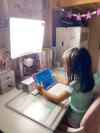Effectiveness of bright light therapy and combination with myopic defocus for controlling myopic eye growth in schoolchildren: study protocol for a randomised controlled trial (phase 1)
- PMID: 40389302
- PMCID: PMC12090853
- DOI: 10.1136/bmjophth-2024-002044
Effectiveness of bright light therapy and combination with myopic defocus for controlling myopic eye growth in schoolchildren: study protocol for a randomised controlled trial (phase 1)
Abstract
Introduction: Myopia and its complications can lead to irreversible visual impairment and even blindness, making this a worldwide public health concern for the 21st century. While treatments to slow myopia progression exist, their average efficacy is moderate. Bright light exposure, either in controlled animal models or naturally under sunlight for children, has demonstrated a protective effect against myopia development. This study hypothesises that bright light therapy (BLT), delivered via a home-based device mimicking sunlight, could slow myopia progression in schoolchildren.
Methods and analysis: We propose a 2-year, double-masked, randomised controlled trial to investigate the effectiveness of BLT and its combination with myopia control treatment in schoolchildren. Chinese schoolchildren aged 7-12 years will be recruited and randomly assigned to one of three arms in phase 1. Subjects will be instructed to perform a minimum of 45 mins of near tasks daily under either BLT (10 000 lux white Light Emitting Diode (LED) light) or placebo light therapy (500 lux white LED light). The control subjects will receive single-vision spectacles and placebo light therapy; the single treatment subjects will receive single-vision spectacles and BLT; and the combination treatment subjects will receive defocus-incorporated multiple segments spectacles and BLT. The primary and secondary outcome measures are changes in cycloplegic objective refraction and axial length over a 2-year period.Treatment dosage is indirectly measured using a monitoring sensor attached beneath the BLT lamp rather than a wearable light metre. Variations in dosage monitoring may influence the observed treatment efficacy.
Ethics and dissemination: The study has been approved by the Institutional Review Boards of The Hong Kong Polytechnic University (HSEARS 20180829002-05) and The University of Hong Kong/Hospital Authority Hong Kong West Cluster (UW 20-362). The study results will be disseminated in scientific conferences and peer-reviewed indexed journals.
Trial registration number: ClinicalTrials.gov identifier: NCT04923841.
Keywords: Clinical Trial; Treatment other.
© Author(s) (or their employer(s)) 2025. Re-use permitted under CC BY-NC. No commercial re-use. See rights and permissions. Published by BMJ Group.
Conflict of interest statement
Competing interests: DY-YT, RKMC, CSYL and CHT received research funding from Hoya Corporation. CSYL and CHT received royalty payments from Hoya Corporation. DY-YT, CSYL and CHT hold patents on myopia treatment using spectacle lenses, contact lenses or pharmaceuticals.
Figures
Similar articles
-
Interventions to slow progression of myopia in children.Cochrane Database Syst Rev. 2011 Dec 7;(12):CD004916. doi: 10.1002/14651858.CD004916.pub3. Cochrane Database Syst Rev. 2011. Update in: Cochrane Database Syst Rev. 2020 Jan 13;1:CD004916. doi: 10.1002/14651858.CD004916.pub4. PMID: 22161388 Free PMC article. Updated.
-
The real-world effectiveness of defocus incorporated multiple segments and highly aspherical lenslets on myopia control: a longitudinal study from the French myopia cohort.BMJ Open Ophthalmol. 2025 Jun 26;10(1):e002142. doi: 10.1136/bmjophth-2025-002142. BMJ Open Ophthalmol. 2025. PMID: 40578905 Free PMC article.
-
Interventions for myopia control in children: a living systematic review and network meta-analysis.Cochrane Database Syst Rev. 2023 Feb 16;2(2):CD014758. doi: 10.1002/14651858.CD014758.pub2. Cochrane Database Syst Rev. 2023. Update in: Cochrane Database Syst Rev. 2025 Feb 13;2:CD014758. doi: 10.1002/14651858.CD014758.pub3. PMID: 36809645 Free PMC article. Updated.
-
Randomised, multicentre, placebo-controlled trial of fenofibrate for treatment of diabetic macular oedema with economic evaluation (FORTE study): study protocol for a randomised control trial.BMJ Open. 2024 Dec 20;14(12):e089518. doi: 10.1136/bmjopen-2024-089518. BMJ Open. 2024. PMID: 39806595 Free PMC article.
-
Laser-assisted subepithelial keratectomy (LASEK) versus laser-assisted in-situ keratomileusis (LASIK) for correcting myopia.Cochrane Database Syst Rev. 2017 Feb 15;2(2):CD011080. doi: 10.1002/14651858.CD011080.pub2. Cochrane Database Syst Rev. 2017. PMID: 28197998 Free PMC article.
References
Publication types
MeSH terms
Associated data
LinkOut - more resources
Full Text Sources
Medical


